まず、ネットワークをキャプチャして、停止する
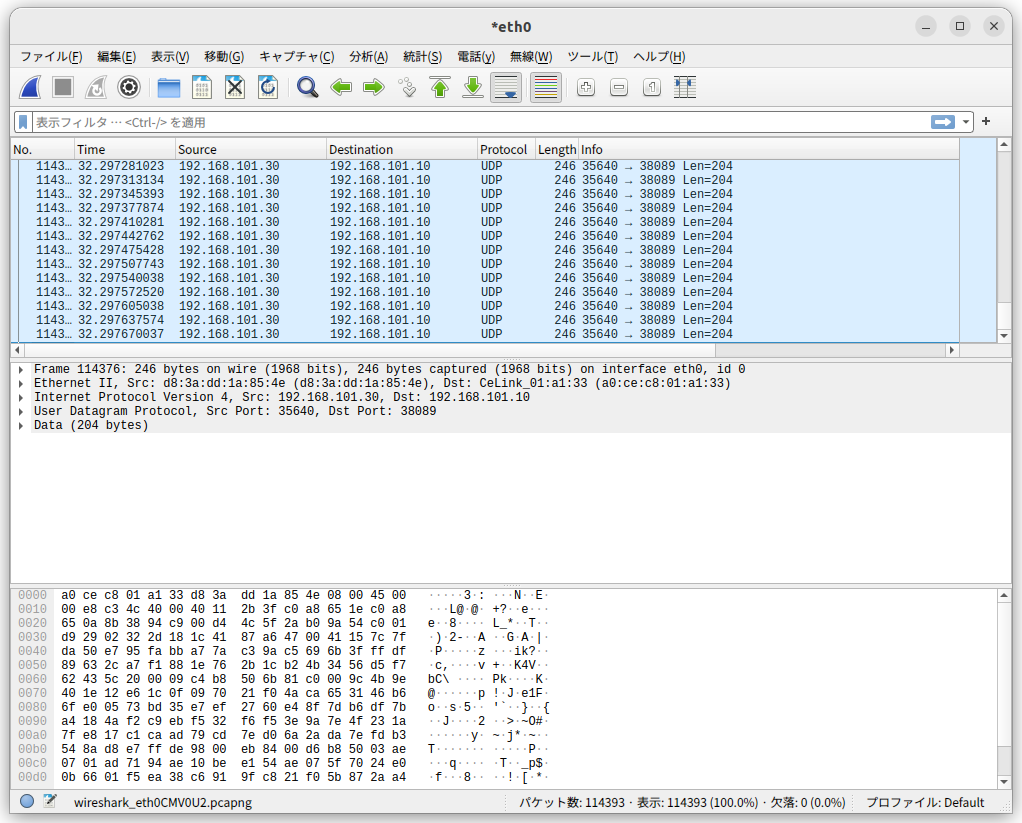
パケットの一つを選んで、「・・・としてデコード」を選択
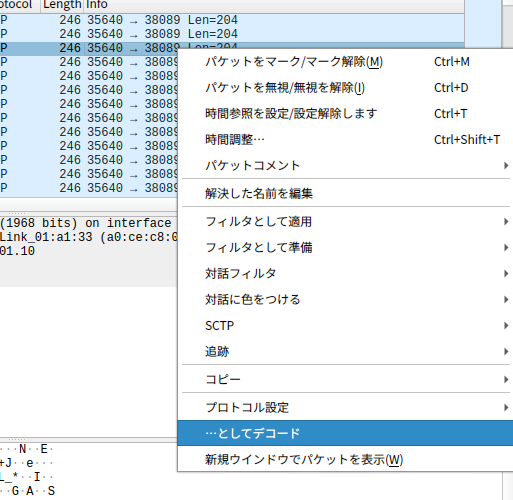
「現在」のところをクリック
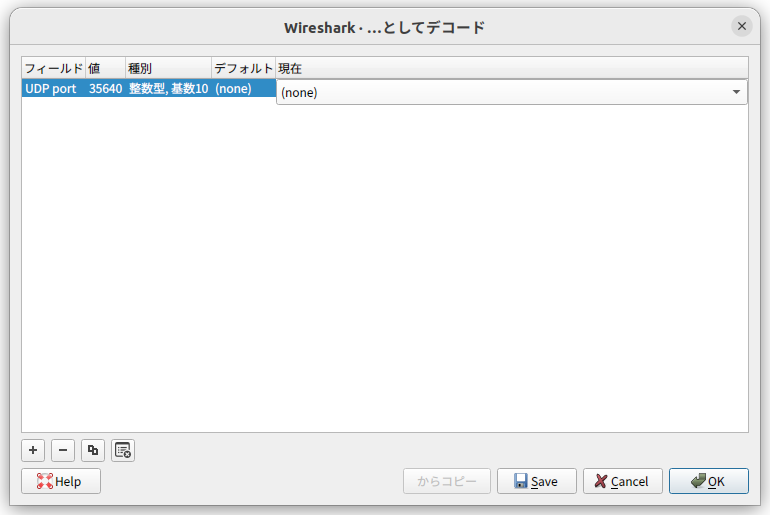
プロトコルとして「RTP」を選ぶ
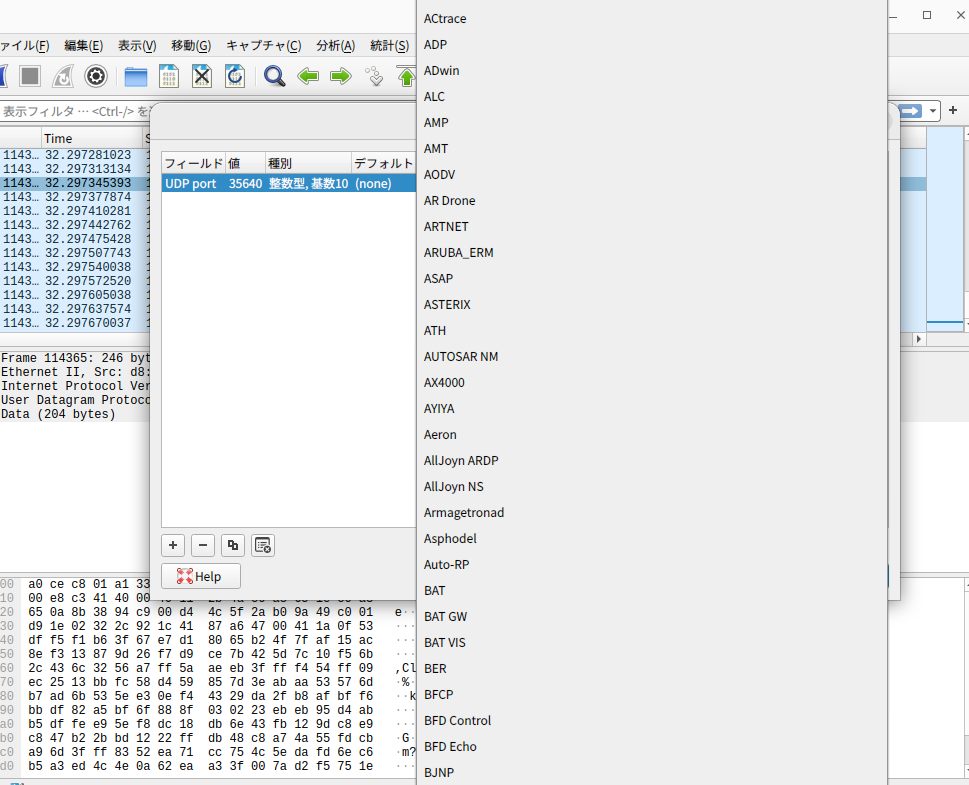
XXXXX
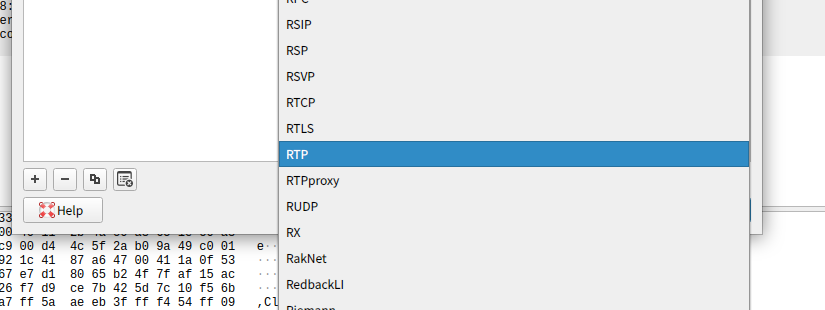
「電話(y)」のメニューを選択
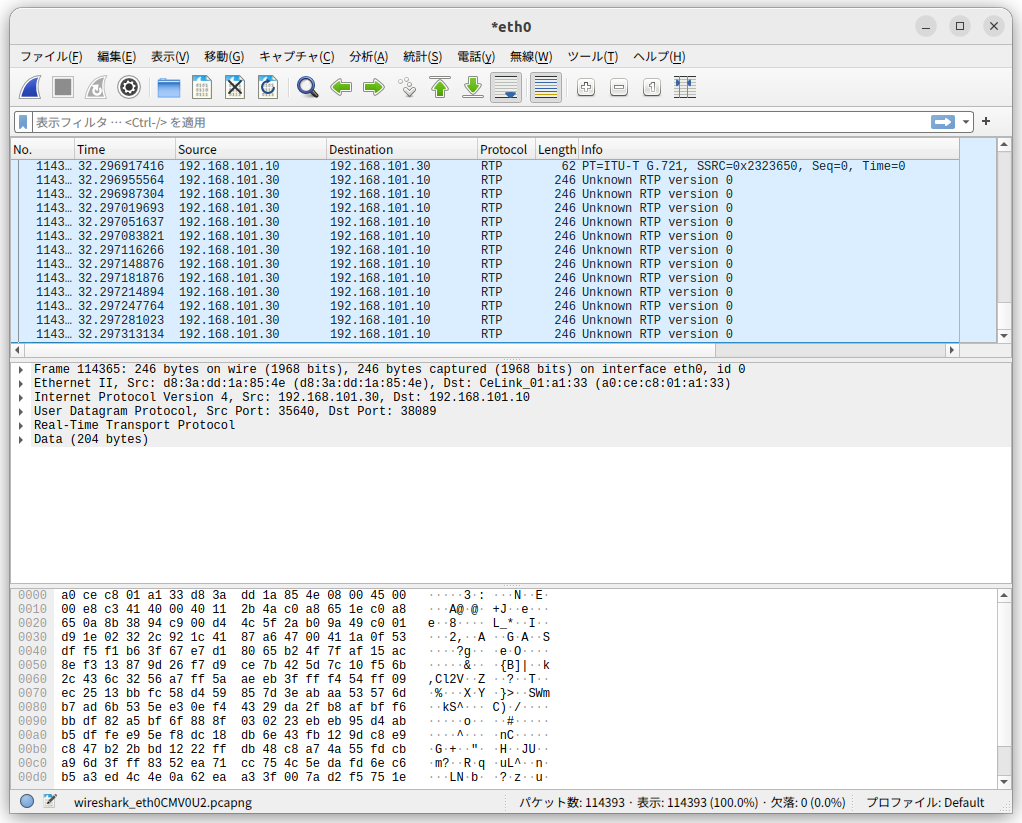
「RTP」→「RTPストリーム」を選択
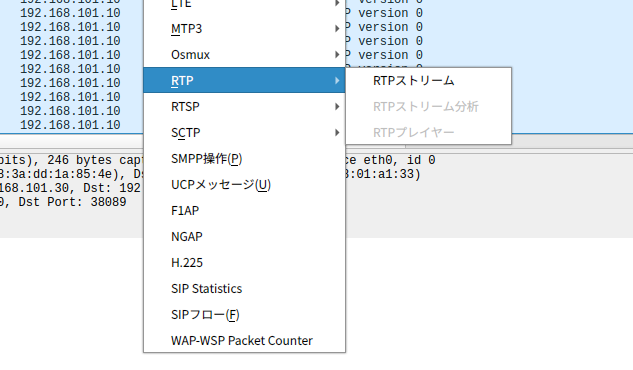
ストリーム一式が表示される
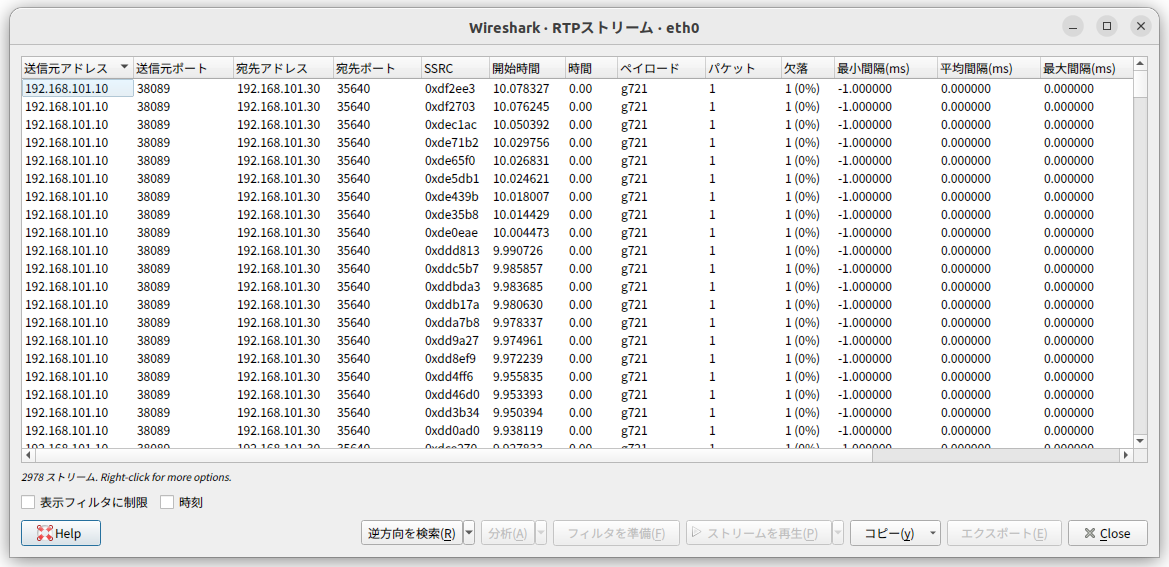
現在、「wiresharkでRTPのパケットロスを検知する方法」には至っていません。
江端智一のホームページ
まず、ネットワークをキャプチャして、停止する

パケットの一つを選んで、「・・・としてデコード」を選択

「現在」のところをクリック

プロトコルとして「RTP」を選ぶ

XXXXX

「電話(y)」のメニューを選択

「RTP」→「RTPストリーム」を選択

ストリーム一式が表示される

現在、「wiresharkでRTPのパケットロスを検知する方法」には至っていません。
今日、発明の検討会に出席しました。
I attended an invention review meeting today.
発明に関する打ち合わせには、ざっくりと、"ブレーンストーミング(ブレスト)"と"承認"の2種類があります。
There are roughly two types of inventions-related meetings: brainstorming and approval.
本日の打ち合わせは、"承認"の方でした。
Today's meeting was for “approval.
承認フェーズでは、発明に関する説明が、論理的で分かりやすいかどうか、のみをチェックして
In the approval phase, only check that the explanation of the invention is logical and easy to understand, and we should pay attention to
『その場の思い付きで、あたらしい発明のネタや、アイデアを言い出してはならない』
"Do not come up with new inventions or ideas on the spur of the moment."
です。
それは"ブレスト"でやるべきであって、"承認"でやると、これまでの作業が全部崩れてしまい、台無しになります。
I should do it in a “brainstorming” session. If done in an “approval” session, all the work done so far will be destroyed and ruined.
こういう、『思い付きでモノ言う上司』が、発明創成を妨げているという話は以前からあり、私もその被害者の一人でした。
It has been said for some time that such “bosses who speak out of ideas” hinder the creation of inventions, and I was one of their victims.
-----
で、こういうことを平気でやるバカ(な上長)は、意外に多いのです。
And there are a surprisingly large number of idiots (superiors) who do this kind of thing with impunity.
たとえば、私です。
For example, I am.
私が、発明業務で十何年にも渡ってパワハラを続けてきたことは、すでに報告済みです。
I have already reported on my decade-long history of power harassment in the invention business.
今日の打ち合わせでも、「いらんこと」を言いそうになって、すんでのところで、思い留まりました。
Even at today's meeting, I almost said something “unnecessary,” then, just as I was about to say it, I stopped myself.
-----
「思いつきでものを言う上司」の被害者から加害者に転じるフェーズは、なかなか分かりにくいです。
It is difficult to determine the phase of turning from victim to perpetrator of “bosses who say things out of the blue.”
なにしろ、私、「永世『被害者』」だと思い込んでいたくらいですから。
After all, I had assumed that I was a “perpetual victim.
ですので、私は『生きているだけで加害者』という意識を持たなければ、と思っています ―― 忘れることも多いですが。
So, I must know that I am a 'perpetrator just by being alive.' I often forget it, though.
以前、私は、最強のダイエット方法は「レコーディングダイエット」である、というコラムを寄稿しました。
I have previously contributed a column on how the most potent diet is a “recording diet.
私のレコーディングダイエットは、簡単です ―― 毎日、体重計に乗るだけです。
My recording diet is simple -- get on the scale every day.
但し、できるだけ条件は一致させるようにしています。私の場合、朝起きて飲食せずに排便した直後、としています。
However, I try to match the conditions as much as possible. In my case, it is immediately after I wake up in the morning and defecate without eating or drinking.
-----
このコラムの中でも書いていますが、
As I write in this column,
=====
―― つまりですね、
-- In short,
などを、自分の身体に直接尋ねるのですよ――。
I ask about my body directly, such as “my body condition."
江端:「ブラックボックスアプローチ*)……」
Ebata: “Black Box Approach*) ......”
*)システム内部を完全に理解しないで、今までのシステムの動きだけを使って行うシステムの理解の方法
(*) How can one understand a system without fully understanding the system's internals, using only the system's movements to date?
=====
私は、今もこれを続けています。
I am still doing this.
これを何年も続けると、「自分の体」というシステムが分かってきます(病気などが分かる訳ではありませんが)。
After years of doing this, I will begin to understand my “body” system (although I will not understand diseases, etc.).
-----
減量が進んでいる時は嬉しいのですが、その原因がはっきり分かっている時は、あながち喜んでもいられません。
I am happy when weight loss progresses, but I cannot be too happy when I know exactly what is causing it.
私の場合、減量の原因のほぼ100%が、「メンタル」であることが分かっているからです。
In my case, I know that almost 100% of my weight loss is due to “mental” factors.
最近、私の体重の減量と増量が、無視できないくらい激しいです ―― だいたい、コーディングか論文の悪夢で目が覚める時期は、そんな感じです。
Lately, my weight loss and gain have been too intense to ignore -- usually around the time I wake up with a coding or paper nightmare.
大切なのは、これが「時期」である、という認識を持つことです。
The important thing is to recognize that this is “the period.”
『いつまでも、この状態が続く』ことはない、と信じることです ―― 実際、信じなければ、やってられません。
I have to believe that it won't “stay that way forever” -- in fact, I cannot help if I don't think it.
ラズパイに、ラズパイにWebカメラ C270n HD 720Pを接続して、RTSPカメラを作ろうとしました。
以下のソースコードをコンパイルしました。
/*
dummy_usbcam_0.2.c
■環境設定を行います。
sudo apt-get update
sudo apt-get install libgstrtspserver-1.0-dev
export PKG_CONFIG_PATH=/usr/lib/x86_64-linux-gnu/pkgconfig:$PKG_CONFIG_PATH
■プログラムをコンパイルして実行するには、以下のコマンドを使用します:
gcc -o dummy_usbcam_0.2 dummy_usbcam_0.2.c `pkg-config --cflags --libs gstreamer-1.0 gstreamer-rtsp-server-1.0`
./dummy_usbcam_0.2 -r rtsp://127.0.0.1:8554/custom -d /dev/video0
■また、ヘルプメッセージを表示するには、以下のコマンドを使用します:
./dummy_usbcam_0.2 -h
■稼動確認環境
(車上) 192.168.101.30
cam@cam-desktop:~/cpp/src$ ./dummy_usbcam_0.2
cam@cam-desktop:~/cpp/src$ ./abc_vtp_0.1 -i 192.168.101.10 -p 38089 -r rtsp://127.0.0.1:8554/test
(地上) 192.168.101.10
pt@pt-desktop:~/go/src$ more srt_rtsp_server_38089.sh
#!/bin/bash
gst-launch-1.0 srtsrc uri=srt://:38089 keep-listening=true ! decodebin ! autovid
eosink
*/
#include <gst/gst.h>
#include <gst/rtsp-server/rtsp-server.h>
#include <stdio.h>
#include <string.h>
void print_usage(const char *prog_name) {
g_print("Usage: %s -r [RTSP_URL] -d [DEVICE]\n", prog_name);
g_print("Default RTSP_URL: rtsp://127.0.0.1:8554/test\n");
g_print("Default DEVICE: /dev/video0\n");
g_print("Example: %s -r rtsp://127.0.0.1:8554/test -d /dev/video0\n", prog_name);
}
int main(int argc, char *argv[]) {
GMainLoop *loop;
GstRTSPServer *server;
GstRTSPMountPoints *mounts;
GstRTSPMediaFactory *factory;
const char *default_url = "rtsp://127.0.0.1:8554/test";
const char *default_device = "/dev/video0";
const char *rtsp_url = default_url;
const char *device = default_device;
char path[256] = "/test";
char service[6] = "8554"; // ポート番号のデフォルト値
for (int i = 1; i < argc; i++) {
if (strcmp(argv[i], "-h") == 0) {
print_usage(argv[0]);
return 0;
} else if (strcmp(argv[i], "-r") == 0 && i + 1 < argc) {
rtsp_url = argv[++i];
// RTSP URLのポート番号とパス部分を抽出
const char *url_port = strchr(rtsp_url + strlen("rtsp://"), ':');
if (url_port != NULL) {
url_port++;
const char *url_path = strchr(url_port, '/');
if (url_path != NULL) {
strncpy(path, url_path, sizeof(path) - 1);
path[sizeof(path) - 1] = '\0'; // Null terminatorを追加
int port_length = url_path - url_port;
if (port_length < sizeof(service)) {
strncpy(service, url_port, port_length);
service[port_length] = '\0'; // Null terminatorを追加
}
}
}
} else if (strcmp(argv[i], "-d") == 0 && i + 1 < argc) {
device = argv[++i];
}
}
gst_init(&argc, &argv);
loop = g_main_loop_new(NULL, FALSE);
server = gst_rtsp_server_new();
gst_rtsp_server_set_service(server, service);
mounts = gst_rtsp_server_get_mount_points(server);
factory = gst_rtsp_media_factory_new();
char launch_string[512];
snprintf(launch_string, sizeof(launch_string),
"( v4l2src device=%s ! videoconvert ! x264enc speed-preset=ultrafast tune=zerolatency ! rtph264pay pt=96 name=pay0 )",
device);
gst_rtsp_media_factory_set_launch(factory, launch_string);
gst_rtsp_mount_points_add_factory(mounts, path, factory);
g_object_unref(mounts);
gst_rtsp_server_attach(server, NULL);
g_print("Stream ready at %s with device %s\n", rtsp_url, device);
g_main_loop_run(loop);
return 0;
}で、
$ ./dummy_usbcam_0.2
をして、
$ gst-launch-1.0 rtspsrc location=rtsp://127.0.0.1:8554/test ! decodebin ! autovideosink
で、映像を受信しようとしたのですが、動きませんでした。
-----
そもそも、"/dev/video0"が見つかりません。
Raspberry PiがWebカメラを認識できるように、必要なパッケージをインストールします。
$ sudo apt-get update
$ sudo apt-get install v4l-utils
v4l-utilsは、Video4Linux(V4L)デバイスを操作するためのツールセットです。
次に、WebカメラがRaspberry Piに認識されているかを確認します。以下のコマンドを実行して、デバイスが認識されているか確認します。
$ lsusb
このコマンドは、接続されているUSBデバイスのリストを表示します。
Bus 001 Device 004: ID 046d:0825 Logitech, Inc. Webcam C270
が表示されれば、成功です。
で、あとはGStreamerでデバイスが動くことを確認しました。
$ gst-launch-1.0 v4l2src device=/dev/video0 ! videoconvert ! autovideosink
後は念の為、GStreamerのインストールができているかを確認して下さい。
$ sudo apt-get update
$ sudo apt-get install gstreamer1.0-tools gstreamer1.0-plugins-base gstreamer1.0-plugins-good gstreamer1.0-plugins-bad gstreamer1.0-plugins-ugly gstreamer1.0-libav
で、
$ gst-launch-1.0 v4l2src device=/dev/video0 ! videoconvert ! autovideosink
で、ローカルにカメラ映像が表示されれば成功です。
で、この後、プログラムを起動して、リモートで、
$ gst-launch-1.0 rtspsrc location=rtsp://192.168.0.200:8554/test ! decodebin ! autovideosink
(192.168.0.200はラズパイのIPアドレスです)
で、RTSPプロトコルで転送された映像が表示されるようになりました。
以上
9月1日の前日の8月31日になると、「余裕のある」大人が、「自殺するかどうか迷っている」子どもたちに、メッセージを発します。
On August 31, the day before September 1, adults with generous hearts send out a message to children who "can't decide whether to kill themselves."
―― 逃げていいんだよ
"You can run away."
と。
この「逃げていいんだよ」メッセージは、仕事で追い込まれて、鬱病になってしまった社会人に対しても良く行われる、無責任で悪質なメッセージです。
The message "you can run away" is also often used for working people who have been pushed to the edge at work and have become depressed. This is an irresponsible and vicious message.
続きはこちら
取り敢えず、今の私からは、
自殺は一週間だけ延期して、実施日を(今年なら)9月9日(月)として下さい
と、だけ申し上げます。
何を言っているか分からないかもしれませんが、何も考えずに、これだけでいいので、私を信じてみてください。
今なお、この「一週間延期」を繰り返して、図々しくこの年齢まで生きてきた大人がいます ―― 私(江端)です。
『「変化を嫌う人」を動かす』という題目の本を見つけました(読んでいません)。
I found a book titled “Motivating People Who Hate Change” (I haven't read it).
私は、こういう題目の本を見つけると、すぐに皮肉を言ってみたくなります。
When I find a book with a title like this, I immediately want to be sarcastic.
――この本の内容は『「変化を嫌う人を動かす」という変化を嫌う人も動かせるのだろうか?
Some people may not like “change that moves people who don't like change.” Can this book change their mind?
と。
この本のアンチテーゼとなる本(の題目)は、『「変化を嫌う人」を放っておく』ですね。
This book's antithesis (the title) is “Letting ‘People Who Hate Change’ alone.”
もっと単純に言えば『人のことなんぞ、ほっとけ』ということです。
More simply put, 'Leave people alone.
-----
「ものごとを動かす側」にいれば、「変化を嫌う人」が恐しく邪魔くさい存在である、ということは、私も身に染みて知っています。
I know firsthand that if you are on the “moving side of things,” people who are averse to change are a terrible hindrance.
自分でも『随分勝手な奴だ』と思うのですが、主催者(ホスト)側にいる私は、「ものごとを動かす」ために、恐しいパワーを発揮して、他人を巻きこもうとします。
I think to myself, “I am a very selfish person,” but as the organizer (host), I try to get others involved, exerting my fearsome power to “get things moving.
これが一転、参加者(ゲスト)側にいる私は、ホストに対して非常に非協力的な存在 ―― 「邪魔くさい存在」になります。
This turns around, and I, on the participant (guest) side, become very uncooperative with the host -- a “distraction.”
-----
これが事実であることは、卑近な例で説明できます。
That this is true can be illustrated by a crude example.
(その1)
(Case 1)
飲み会の主催者は、会場の手配、時間の調整、そして出席者数の把握の為に奔走します。これらをきちんと管理しないと、飲み会というイベントが成立しないからです。
The organizer of a drinking party is scrambling to arrange a venue, coordinate time, and keep track of the number of attendees. Without proper management of these matters, the event of a drinking party would not be possible.
比して、飲み会の出席者は、なかなか出欠の返事をしませんし、当日、平気でドタキャンをします。そして、お金だけ払うだけで、免責されたかのように振舞います。
In contrast, attendees at a drinking party are slow to reply to a call for attendance and cancel without hesitation on the day of the party. They only pay the fee and act as if they are exempted from liability.
(その2)
(Case 2)
会議を進行する司会者や、結婚式の司会者は、当日のスケジューリングを秒単位で管理しなければなりませんが、発言者やスピーチをする人間は、そんなことを気にせずに、好きなように振舞い、イベントそのものを破壊します。
The moderator who facilitates a meeting or the host of a wedding has to manage the day's scheduling down to the second, but the speaker or the person giving the speech doesn't care about that; they behave as they please and destroy the event itself.
私の経験上、時間を気にしないでスピーチを続ける奴のスピーチの内容は、"退屈"どころか"苦痛"であり、さらにその内容は"低能"だったりします。
In my experience, the content of speeches given by people who do not pay attention to the time is not only “boring” but also “painful,” and their content is often “inept.
以前、以下の日記で、『プレゼン能力絶無の小中校の学校の校長の話』をしました。
I previously wrote about a principal in elementary and middle schools with no presentation skills.
嫁さん:「いや、それは違うと思う。パラリンピックのアスリートの人たちの、あの物凄いパフォーマンスを、私たちの人生の一場面と見なすのには、無理がある」
基本的に「人は、自分以外の人やコトに興味がない」ものです。
“People are not interested in people or things other than themselves.
こんな基本的なことも知らないで、大人をやっている大人は、意外なほど多いです。
Surprisingly, many adults are doing adult work without knowing these basic principles.
いずれにしても、『「変化を嫌う人」を動かす』というのは、かなり難しいことは事実です。
In any case, it is true that 'moving people who don't like change' is quite tricky.
-----
私は、この本を批判している訳ではありません ―― そもそも、まだ読んでいないです。
I am not criticizing the book -- I haven't read it yet.
なので、先程図書館に予約入れておきました。
So I just made a reservation at the library.
読んだ後で、また感想を書きます。
I will write more thoughts after I read it.
もしかしたら、この本に刺激を受けて、『「変化を嫌う人」を放っておく』というコラムの執筆意欲が湧いてくるかもしれません。
Perhaps this book will inspire me to write a column titled “Letting People Who Hate Change Alone.”
今、我が国には、歴史的にも例のない巨大台風が日本列島を覆っています。
Our country is experiencing a massive typhoon that is unprecedented in history, covering the Japanese archipelago.
そのまま国土全土を蹂躙していく勢いです。
It is on the verge of overrunning the entire country as it is.
今朝、町内を車で見回りしてきたのですが ―― 正直怖かった。
I drove around town this morning -- honestly, I was scared.
道路冠水箇所多数、マンホールの蓋が外れて水が吹き上がっているケース2, 土手からの流水箇所2でした。
There were many flooded areas on the road, 2 cases where maintenance hole covers had come off, and water was blowing up, and two areas where water was running down from the banks.
我が家は、県境の雑木林から、直線距離で100メートル以内のところにあります。
Our house is 100 meters from a wooded area on the county border.
ハザードマップで調べたところ"セーフ"となっているようですが、土石流が我が家を直撃することが「絶対にない」とは言えないと思っています。
Although the hazard map shows it is “safe,” I cannot say that a mudslide will never hit my house.
-----
昨夜から2度に渡る緊急アラートで叩き起されて寝不足です。
I am sleep-deprived after being knocked up by two emergency alerts since last night.
2度目のアラートは「避難指示」の発令でした。
The second alert was the issuance of an “evacuation order.
でも、どこへ?
But where to?
高台にある我が家は、池のそばにある公民館よりも、高台にあります。
Our house is on higher ground than the community center by the pond.
土石流が発生する場合も、最初の被害箇所は『だいたい、あそこ』と予測できています。
When a mudslide occurs, I can predict the initial damage is approximately there.
現在のところ、江端家の方が"圧倒的"に安全と言えそうです(「江端家の家訓」ご参照)
At present, Ebata's house seems to be “overwhelmingly” safer (see “Ebata Family Instructions”).
-----
コミック&アニメの「ヨルムンガンド」によれば、『21世紀の戦争は「エネルギー争い」から「水争い」になる』という予測がされています。
According to the comic & anime “Jormungandr,” it is predicted that “wars in the 21st century will go from ‘energy wars’ to 'water wars.
たしかに、エネルギーよりも、水の方が、生存に直結します。実際に、ここ10年の気候変動で、世界中で干ばつ被害が広がっているようです。
Indeed, water is more directly related to survival than energy. Climate change in the last decade seems to have caused widespread drought damage worldwide.
チオピア、ソマリア、ケニアなどが含まれるアフリカの角地域、アメリカ合衆国の西部地域、特にカリフォルニア州、アリゾナ州、ネバダ州、オーストラリア、南米(ブラジル)あたりが上げられそうです。
The Horn of Africa region, which includes Ethiopia, Somalia, and Kenya, and the western region of the United States, especially California, Arizona, Nevada, Australia, and South America (Brazil), are likely that
一方、我が国では、ここ数年、太平洋の海水が温められて膨大な水源のかたまりとなった巨大台風が、日本の国土に、その水を全部ぶちまけていきます。
Meanwhile, in our country, in the past few years, a massive typhoon that has heated the Pacific Ocean waters into an enormous chunk of water source has been spewing all of its water over the land of Japan.
1台風、平均200億トン。
1 typhoon, 20 billion tons on average.
ChatGPTさんに尋ねたところ、これ、ナイアガラの滝約74日分の水量、だそうです。
I asked ChatGPT about this, and he said that this is the equivalent of about 74 days of water from Niagara Falls.
で、今回の台風が、どれくらいの水を持ち込んでいるか、ChatGPTさんにフェルミ推定してもらったら「3925億トン」だそうです。
So, I requested ChatGPT to give me a Fermi estimate of how much water this typhoon is bringing in, and it said it is “392.5 billion tons”.
ナイアガラの滝約1452日間分 → 4年間分
Niagara Falls approx. 1452 days → 4 years
今回の台風は、日本全土が台風で沈没しかねないスケールです。
This typhoon is on a scale that could sink all of Japan in a typhoon.
(まあ、ChatGPTの計算は、眉唾ですので、あくまでご参考まで(『検算したら2ケタ違っていた』など、ざらにあります))
(Well, the ChatGPT calculations are eyebrow-raising, so they are for reference only (it is not uncommon to find a “two-digit difference” when calculating).
-----
我が国が、水の豊かな国であることには、大変助かっているのですが、別段、私達は、日本列島を水没させて欲しいわけではありません。
We are very grateful that our country is rich in water. However, we do not wish to see the Japanese archipelago submerged.
自然の方でも、色々配慮して欲しい ―― と、私は、本気で思っています。
I hope that nature will give much consideration -- and I mean it.
NetFlixで今人気のコンテンツである「地面師たち」、とても面白かったです。
I enjoyed “The Land Fraud Group,” the most popular content on NetFlix.
自宅でこういう楽しいコンテンツを見せられると、映画館に出向くモチベーションが下がりますね。
Watching this fun content at home makes me less motivated to go to the movie theater.
それにしても、
Aside from that, I think that
―― この「地面師たち」は、新人教育だけでなく、社員教育の素材としても使えるんじゃないか?
"The Land Fraud Group” is excellent material for training new employees and employee training."
とか考えています。
------
この映画のテーマの一つは、社内稟議です。
One of the themes of the film is the internal approval process.
稟議は本当に鬱陶しいです。時間かかるし、口出しされるし、不本意な内容変更にも応じないとならないからです。
The approval process is depressing. It is time-consuming, they interfere with you, and you have to agree to unwilling changes in the content.
たぶん、社内稟議によって、我が国の企業の多くはビジネスチャンスを失っているだろう、とも思います。
Perhaps many of our country's companies are losing business opportunities due to internal approvals, I also think.
しかし、この「地面師たち」は、社内稟議の重要性を、ゾクッとするほどリアルに教えてくれます。
However, the “Land fraud group” gives a chillingly realistic view of the importance of the internal approval process.
そして、幹部クラス自らがコンプライアンス違反をすれば、稟議のルールが簡単に有名無実化してしまうことも、明らかにしています。
It is also clear that the approval rules can easily corrupt if the executive class violates compliance.
『数日で稟議を回さなければ、100億円のビジネスがすべてパーになる』と言われれば、私でも、稟議システムにチャレンジしてみよう、という気になったかもしれません ―― が、安心して下さい。
If someone told me, “If you don't get approval in a few days, your 10 billion yen business will all go up in smoke,” even I might try the approval system -- but don't worry.
私には、そんな権限も権能もチャンスありませんので、そんなチャレンジとは一生無関係です。
I have no authority, power, or chance, so I will forever be irrelevant to that challenge.
-----
私は、キャリアをかなり早い段階で諦めて、好きな駄文作成と、(時々は好きでもない)コーディングをやる道を選びました。
I gave up my career reasonably early on and chose to do the crap writing I love and the coding I do (and sometimes don't even like).
この道でも不愉快なことは多いのですが、『稟議システムにチャレンジする』などという野望を持つチャンスがなかったことは、かなり幸せなことだったのだなぁ、と思ってはいます。
This path has a lot of unpleasantness, but I am pretty happy that I never had the chance to have ambitions such as 'challenging the approval system.'
"1500円 + 翌日"と、"2週間 + 書類作成 + 何回もの稟議"を秤にかけて、Amazonの購入ボタンに手が出てしまう私を、一体、誰が責められましょうか。
docker images をやったのですが、同じ名前のdocker imagesが出てくるのですが、どれが最新なのか見分ける方法を教えて下さい。
↓
同じ名前のdocker imagesが出てくるのですが、どれが最新なのか見分ける方法を教えて下さい。
↓
CREATED も同じく"2months"になっていて見分けがつきません。 ですので、例えば、Dockerコンテナを動かして確認する方法はありませんか。現在、私は "docker-compose start" をした後にシェルでDocker内部に入っているのですが、この状況からの確認方法を教えて下さい
Dockerの外側(ホストOS)から稼働中のDockerコンテナを確認するには、いくつかの方法があります。以下は、その代表的な方法です。
docker ps コマンドで稼働中のコンテナを確認ホストOS上で、現在稼働中のコンテナを一覧表示するために、以下のコマンドを使用します。
docker pscam@cam-desktop:~$ docker ps
CONTAINER ID IMAGE COMMAND CREATED STATUS PORTS NAMES
c928a6ab4e6b u2404b-dev-environment "/bin/bash" 4 days ago Up About an hour u2404b-dev-environment-1という表示がでてきました。
このイメージをsaveする方法を教えてください。
1. イメージを保存する
まず、docker save コマンドを使用してイメージをファイルに保存します。以下のコマンドを実行してください。
$ docker save -o u2404b-dev-environment.tar u2404b-dev-environment
このコマンドは、u2404b-dev-environment という名前のイメージを u2404b-dev-environment.tar というファイルに保存します。
2. 保存されたファイルを確認する
保存が完了したら、ファイルが正しく作成されたか確認します。
$ ls -lh u2404b-dev-environment.tar
このコマンドで、保存されたファイルが存在し、適切なサイズであることを確認できます。
あとは、zip等で固めて、先方に送付すればO.K.
-----
保存したイメージを他の環境でロードするには、どうしたら良いですか。
もし他の環境に移動してこのイメージを使用したい場合、docker load コマンドを使用してイメージをロードします。
ファイルを解凍して、
$ docker load -i u2404b-dev-environment.tar
これにより、保存されたイメージが再びDockerにインポートされ、使用可能になります。
ところが、この方法では、自力で設定した環境などが全く引き継がれないらしいです。
送付いただいたものはgstreamer、コンパイル環境が入っていない状態でした。
お手数ですが、コンテナをcommitしてsaveしたものを送付願います。
(参考:https://sagantaf.hatenablog.com/entry/2018/09/04/190801)
上記の参考資料の通りにやってみることにしました。
(Step.1) まず、ゲストOSを立ち上げておいて、ホストOSから以下のコマンドを投入します
cam@cam-desktop:~$ sudo docker ps
CONTAINER ID IMAGE COMMAND CREATED STATUS PORTS NAMES
c928a6ab4e6b u2404b-dev-environment "/bin/bash" 4 days ago Up 3 hours u2404b-dev-environment-1
(Step.2) 次に、このc928a6ab4e6bを使って、20240828_shajyoという名前(名前は好きなように)でコミットします
cam@cam-desktop:~$ sudo docker commit c928a6ab4e6b
20240828_shajyo
sha256:ac3405c474d294e5b5d0bd9a8cdc51a600f8cd3d04685877cecfb772e284b17e
# コミットしている最中、ゲストOSにアクセスできなくなるようですが、恐れず、じっと我慢しましょう。
(Step.3) コミットに成功しているかを確認します
cam@cam-desktop:~$ sudo docker images
REPOSITORY TAG IMAGE ID CREATED SIZE
20240828_shajyo latest ac3405c474d2 4 minutes ago 2.5GB ← できている
u2404b-dev-environment latest 48248de5e524 2 months ago 1.23GB
<none> <none> dcb4a05fb5a5 2 months ago 1.23GB
<none> <none> 132165fbb602 2 months ago 986MB
u2404_dev-environment latest 940f87bcbccf 2 months ago 986MB
<none> <none> a4252fdea034 2 months ago 988MB
u2404-dev-environment latest a042684decc4 2 months ago 971MB
ubuntu 24.04 ffb64c9b7e8b 2 months ago 101MB
hello-world latest ee301c921b8a 16 months ago 9.14kB
(Step.3) 20240828_shajyoをセーブします
cam@cam-desktop:~$ docker save 20240828_shajyo -o 20240828_shajyo.tar
あとは、これをzip等で圧縮して、先方にお送りすれば良いです。
cam@cam-desktop:~$zip 20240828_shajyo.tar.zip 20240828_shajyo.tar
-----
これを展開するのは、多分、以下のようになると思います(というのは、私が試していないからです)
(Step. 1) 一旦、ホストOSからイメージを削除する
$ docker images
REPOSITORY TAG IMAGE ID CREATED SIZE 20240101_shajyo latest 3c053ce8d919 25 minutes ago 193MB
$ docker rmi 20240101_shajyo
(Step. 2) ホストOSから、ファイルからイメージを作成する
$ sudo docker load < 20240828_shajyo.tar
これでイメージが復活する(ハズ)とのことです。
ご対応ありがとうございました。
コンパイル環境と各プログラムがイメージに入っていることを確認しました。
というコメントをいただいたので、多分大丈夫です。
=======
今回イメージを受けとる側になりましたので、イメージの作成方法を追記します。
cam@cam-desktop:~/u2404b$ docker-compose start
service "dev-environment" has no container to start
と言われてしまいました。
まず、docker-compose.ymlのディレクトリに行きます。
現在のコンテナ状況を確認するため、以下のコマンドを実行します:
出力が空の場合、まだコンテナが作成されていないことを意味します。
$ sudo docker load < 20241016_shajyo_latest.tar
でつくったもので
20241016_shajyo latest bf4a5d825daa 13 months ago 3.15GB
となっています。
もし 20241016_shajyo:latest を docker-compose.yml 内で使用する予定がある場合、以下の手順を考慮してください。
docker-compose up コマンドで、コンテナを作成して起動します:
--build は、新しいビルドが必要な場合に使用します。-d は、デタッチモード(バックグラウンドで実行)を有効にします。このコマンドで新しいコンテナが作成され、サービスが開始されます。
ところが、これでもDockerで作ったデータベース本体丸ごとでの移行はしないみたいです(ちょっと待った。現在これ検証中)。
結論:docker commit ではデータは移行されない可能性が高い!
データベースごと移行するなら
docker volume をバックアップするか、pg_dump を使うべき
データベース本体と丸ごと持っていきたい場合は(も、あてにならないので、現在検証中)